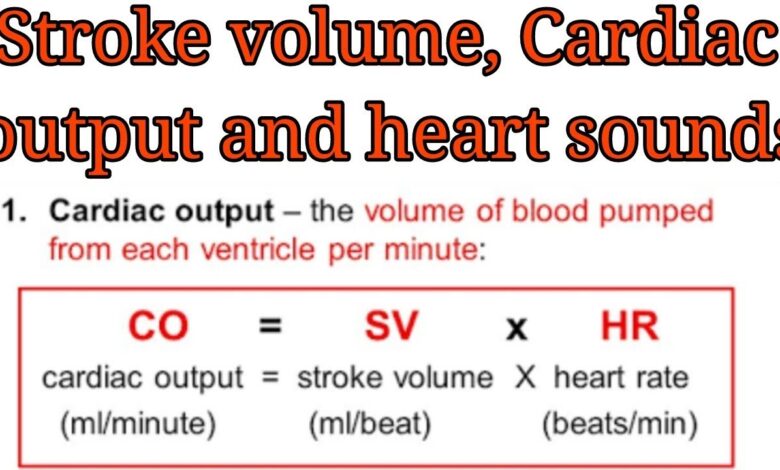Understanding the Stroke Volume Equation: The Key to Heart Health

When it comes to understanding heart health, few metrics are as important as Stroke volume equation. Stroke volume is a measurement of the amount of blood pumped by the heart with each beat, and it’s essential for determining how effectively the heart is working. To measure stroke volume, we use the stroke volume equation. In this article, we’ll break down what stroke volume is, how the stroke volume equation works, and why it matters for both athletes and those with heart conditions.
What is Stroke Volume?

In simple terms, Stroke volume equation is the amount of blood that the heart pumps out each time it beats. It’s one of the primary indicators of heart function, alongside other measures like heart rate and cardiac output. Stroke volume helps doctors understand how well the heart is pumping and whether it’s delivering enough blood to meet the body’s needs.
Why Stroke Volume Matters
Stroke volume is crucial because it affects your body’s ability to receive oxygen-rich blood. When stroke volume is too low, it can lead to fatigue, shortness of breath, and other symptoms related to low blood flow. For athletes, a higher stroke volume often means better endurance and performance, while for patients with heart conditions, monitoring stroke volume can be key to managing their health.
The Basics of the Stroke Volume Equation
The stroke volume equation allows us to calculate the exact amount of blood pumped by the heart with each beat. This calculation involves two other measurements: the end-diastolic volume (EDV) and the end-systolic volume (ESV).
The formula is as follows:
Stroke Volume (SV)=End-Diastolic Volume (EDV)−End-Systolic Volume (ESV)\text{Stroke Volume (SV)} = \text{End-Diastolic Volume (EDV)} – \text{End-Systolic Volume (ESV)}Stroke Volume (SV)=End-Diastolic Volume (EDV)−End-Systolic Volume (ESV)
- End-diastolic volume (EDV): The total amount of blood in the ventricles (the heart’s lower chambers) right before they contract.
- End-Systolic Volume (ESV): The amount of blood left in the ventricles right after they contract.
By subtracting the ESV from the EDV, we get the stroke volume, which tells us how much blood the heart pumps out with each beat.
Understanding Key Components of the Stroke Volume Equation
To fully understand the stroke volume equation, let’s take a closer look at EDV and ESV.
- End-Diastolic Volume (EDV): This value reflects how much blood fills the heart at the peak of relaxation before contraction. A higher EDV usually means a higher stroke volume, as more blood is available to be pumped out.
- End-Systolic Volume (ESV): After the heart contracts, some blood remains in the ventricles. This leftover blood is called ESV. If ESV is lower, it typically means a more efficient heartbeat, as less blood is left behind.
Example Calculation
Let’s say a person has an EDV of 120 mL and an ESV of 50 mL. Using the stroke volume equation:
SV=120 mL−50 mL=70 mL\text{SV} = 120 \, \text{mL} – 50 \, \text{mL} = 70 \, \text{mL}SV=120mL−50mL=70mL
In this case, the stroke volume would be 70 mL, meaning the heart pumps out 70 mL of blood with each beat.
How Stroke Volume Impacts Cardiac Output
Stroke volume plays a big role in determining cardiac output (CO), which is the total amount of blood the heart pumps per minute. Cardiac output depends on both stroke volume and heart rate. The equation for cardiac output is:
Cardiac Output (CO)=Stroke Volume (SV)×Heart Rate (HR)\text{Cardiac Output (CO)} = \text{Stroke Volume (SV)} \times \text{Heart Rate (HR)}Cardiac Output (CO)=Stroke Volume (SV)×Heart Rate (HR)
For example, if a person has a stroke volume of 70 mL and a heart rate of 70 beats per minute, their cardiac output would be:
CO=70 mL×70 bpm=4900 mL/min\text{CO} = 70 \, \text{mL} \times 70 \, \text{bpm} = 4900 \, \text{mL/min}CO=70mL×70bpm=4900mL/min
This means the heart pumps out 4900 mL (or 4.9 liters) of blood per minute.
Factors That Affect Stroke Volume
Stroke volume isn’t a static number; it can change depending on various factors, including:
- Physical activity – During exercise, stroke volume often increases to supply muscles with more oxygen.
- Heart health – Heart conditions, like heart disease or heart failure, can reduce stroke volume.
- Hydration levels – Dehydration can lower stroke volume since there’s less blood circulating through the body.
- Body position – Stroke volume is typically higher when lying down than standing up.
Factors that Increase Stroke Volume
Several factors can contribute to an increased stroke volume:
- Higher blood volume: With more blood circulating, the heart has more to pump.
- Improved heart muscle strength: A stronger heart muscle pumps blood more efficiently.
- Increased venous return: More blood returning to the heart helps fill the ventricles more fully, raising EDV.
Factors that Decrease Stroke Volume
Conversely, certain factors may decrease stroke volume:
- Heart damage: Damage from heart disease or heart attacks can weaken the heart’s ability to pump effectively.
- Decreased blood volume: Loss of blood through dehydration or bleeding reduces the available blood for pumping.
- High blood pressure: The heart has to work harder to pump blood against high pressure, which can reduce efficiency.
Importance of Stroke Volume for Athletes
For athletes, stroke volume is an indicator of cardiovascular fitness. A high stroke volume allows more oxygen to reach the muscles, which improves endurance and performance. Athletes often train to increase their stroke volume, as a higher stroke volume means the heart doesn’t need to beat as often to deliver the same amount of blood. This lower heart rate can be beneficial for overall heart health.
How to Measure Stroke Volume
There are various methods to measure stroke volume, including:
- Echocardiography: This imaging test uses ultrasound to provide detailed images of the heart and measure blood flow.
- Magnetic Resonance Imaging (MRI): MRI scans provide a precise measurement of the heart’s chambers and the volume of blood pumped.
- Catheterization: In more invasive procedures, a catheter can measure the blood pressure and volume directly.
Each method has its advantages and is chosen based on the patient’s needs and health status.
Table of Stroke Volume Values in Different Conditions
Here’s a table showing typical stroke volume ranges for different conditions:
ConditionAverage Stroke Volume (mL/beat)
Resting, Non-Athlete 60 – 80
Resting, Athlete 90 – 110
Moderate Exercise 120 – 130
Intense Exercise (Athlete) 150 – 200
Heart Failure of Less than 60
This table shows how stroke volume varies based on activity levels and health.
Improving Stroke Volume: Tips for a Healthier Heart
Improving stroke volume can contribute to better cardiovascular health. Here are some tips:
- Exercise regularly: Cardiovascular exercises like running, swimming, or cycling improve heart strength and can increase stroke volume.
- Stay hydrated: Keeping blood volume up helps ensure adequate stroke volume.
- Manage blood pressure: Lowering high blood pressure allows the heart to pump more efficiently.
- Eat a heart-healthy diet: Foods high in omega-3 fatty acids, like fish, and those high in antioxidants, like fruits and vegetables, support heart health.
Stroke Volume Equation in Summary
The stroke volume equation provides valuable insights into heart health by measuring how much blood the heart pumps with each beat. Understanding stroke volume can be immensely beneficial to athletes aiming to improve performance, patients managing heart conditions, or anyone interested in better health.
Wrapping Up: Why the Stroke Volume Equation Matters
In conclusion, the stroke volume equation is more than just a calculation; it’s a critical measure of heart efficiency and overall health. By understanding this equation, you gain insight into how your heart functions, helping you make informed decisions about your health. Whether tracking fitness improvements or managing heart conditions, using the stroke volume equation offers a clear, measurable path to better heart health.





